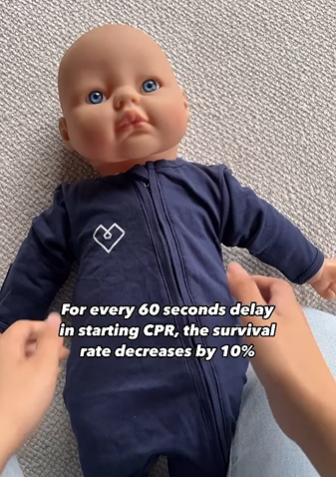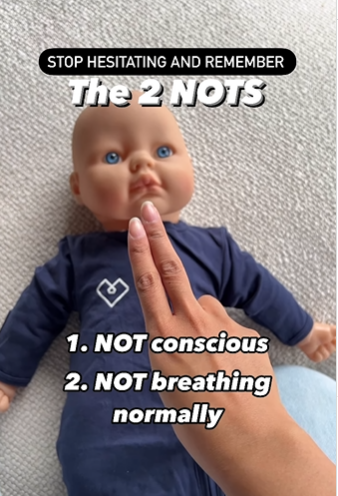But according to an ex-paramedic, delaying starting CPR by just a minute could bring down your child’s chances of survival.
So it’s critical to be aware of key signs indicating that your tot needs this lifesaving intervention.
“No parent ever wants to use this skill, but every parent wants to have the confidence that if they needed to, they absolutely could,” Nikki Jurcutz, the first-aider behind Tiny Hearts Education, said.
“CPR saves lives,” she wrote in a recent Instagram post.
CPR stands for cardiopulmonary resuscitation. It’s a lifesaving procedure that should be used when a child’s breathing or heartbeat has stopped.
This might happen if your child chokes on food or an object or if they drown, suffer a serious head injury, excessive bleeding or an electric shock, according to Mount Sinai.
Knowing how to do CPR can give your baby the best chance of survival.
To identify if your baby needs CPR, Nikki said you need to keep two red flags in mind, which she called the “two NOTS”.
You need to intervene immediately if your little one is:
- Not conscious
- Not breathing normally
Mount Sinai adds that you should also attempt CPR if your little one has no pulse.
A useful way to check if you little one is breathing is to look at their chest or tummy for any movement.
You can nudge your tot gently to see if their respond to your touch, or flick the soles of their feet.
You can even call out their name or loudly ask “are you OK?”.
If your child doesn’t move or make a sound, this can be a key sign that they need CPR.
The NHS recommends you check your little one’s breathing by keeping the airway open and putting your face close to your child’s face and looking along their chest.
You should:
- Look for chest movements.
- Listen at the child’s nose and mouth for breathing sounds.
- Feel for air movement on your cheek
But you shouldn’t look, listen and feel for no more than 10 seconds, as delay in CPR can lessen their chances of survival.
“Gasping breaths should not be considered to be normal breathing,” the NHS noted.
According to Nikki: “For every 60 seconds delay in staring CPR, the survival rate decreased by 10 per cent.”
You shouldn’t attempt CPR if you tot responds to your nudges or calls by answering or moving.
Instead, leave them in the position you found them in – provided they’re not in danger – and asses what kind of help they need.
You also shouldn’t give CPR if your baby is conscious but cannot move, or they are unconscious but breathing normally, according to the British Heart Foundation.
How to give your baby CPR
IF you’ve established that your baby is unresponsive and not breathing normally, it’s time to start CPR.
Step 1. Check for breathing
Tilt your baby’s head back and look and feel for breaths.
If they’re not breathing move on to step two.
Step 2. Tell someone to dial 999
If you’re on your own carry out rescue breaths, and chest compressions described below for one minute, then dial 999.
Step 3. Give five rescue breaths
Tilt your baby’s head back, seal your mouth over their mouth and nose and blow steadily.
Repeat five times.
Step 4. Give 30 chest compressions
Push firmly in the middle of your baby’s chest with two fingers and then release.
Maintain a regular rate of around two compressions per second.
Repeat 30 times.
Step 5. Give two rescue breaths
Then continue with cycles of 30 chest compressions and two rescue breaths until help arrives.
If the baby shows signs of becoming responsive, such as, coughing, opening their eyes, making a noise, or starts to breathe normally, put them in the recovery position – cradle the baby in your arms, with their head tilted downwards to prevent them from choking or inhaling vomit.
Monitor their level of response and prepare to give CPR again if necessary.
Source: St John Ambulance

